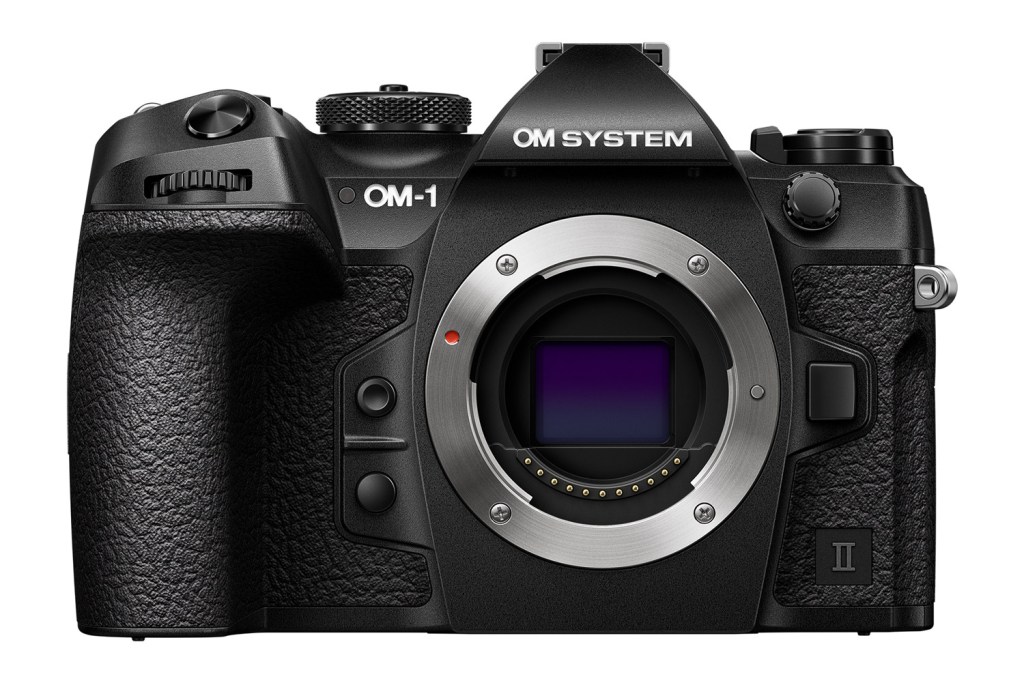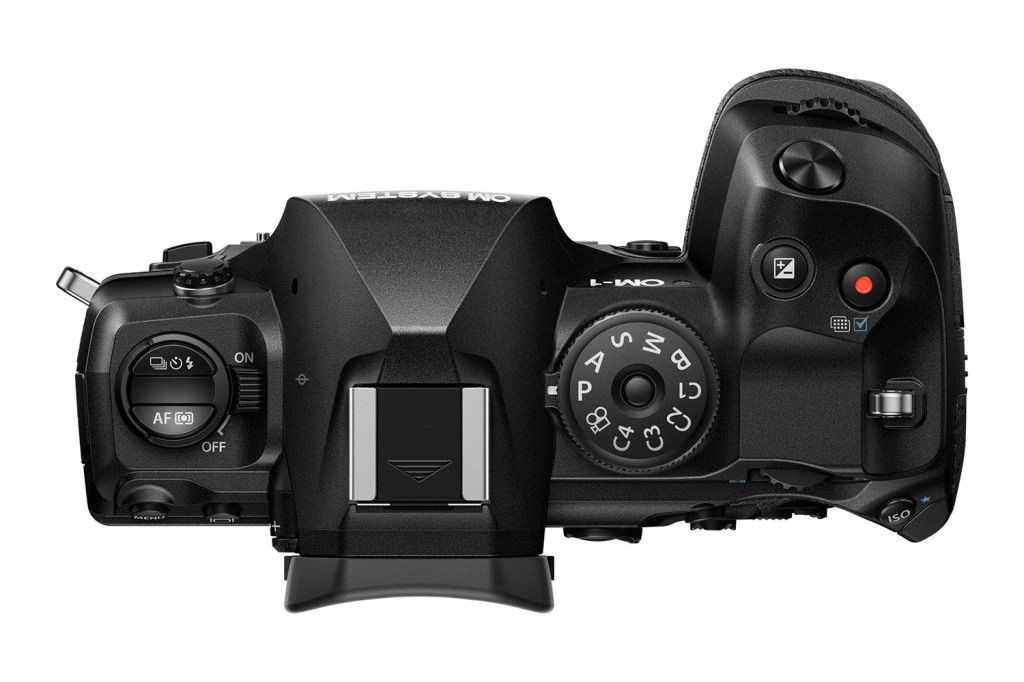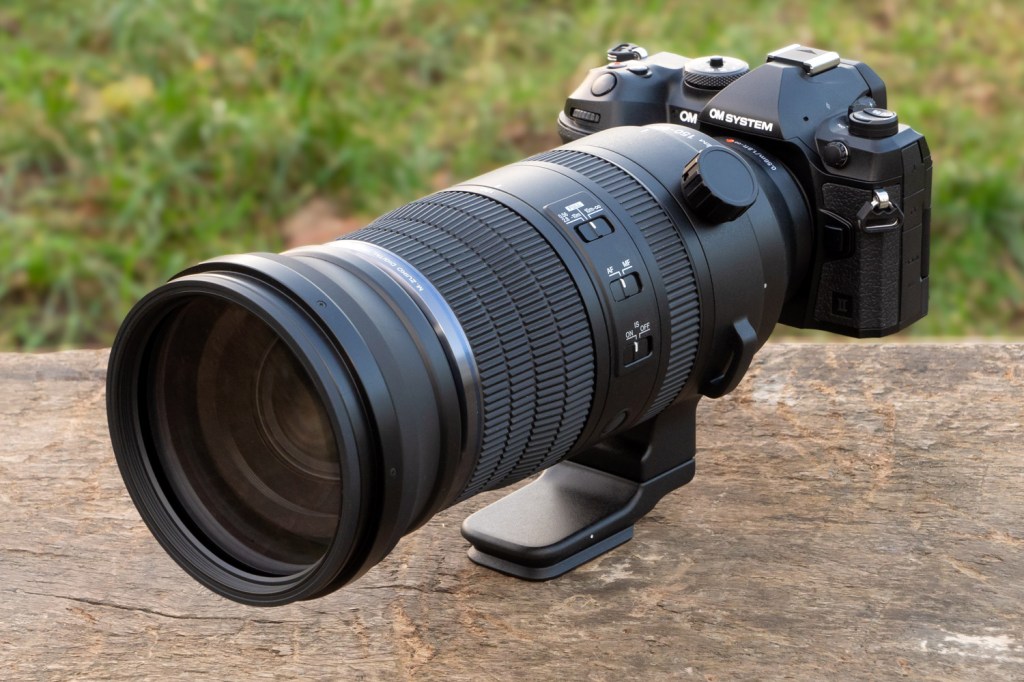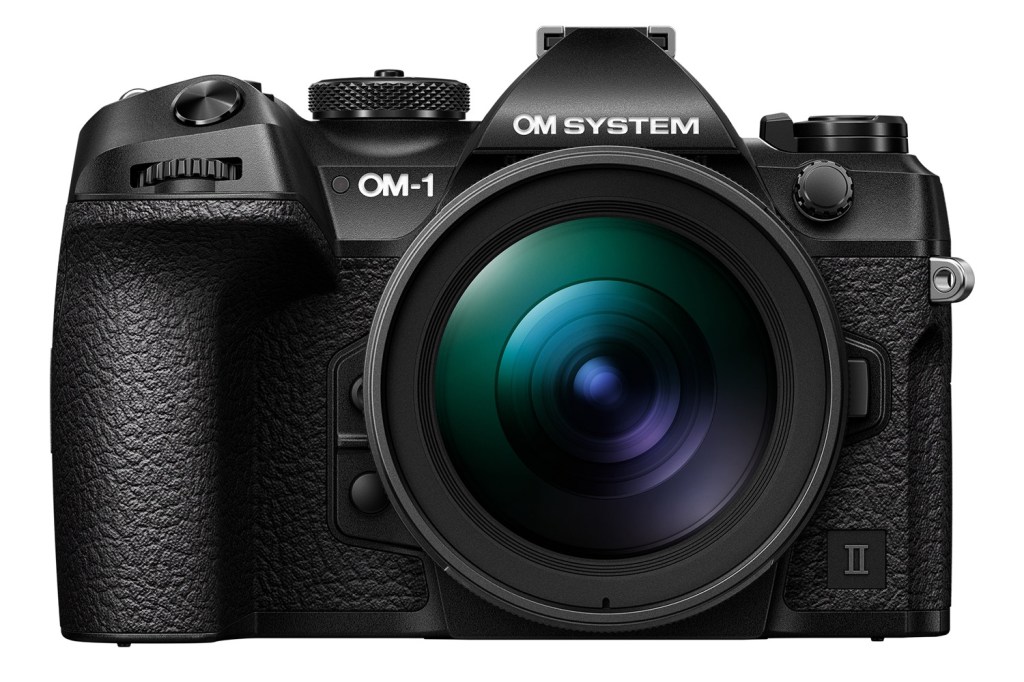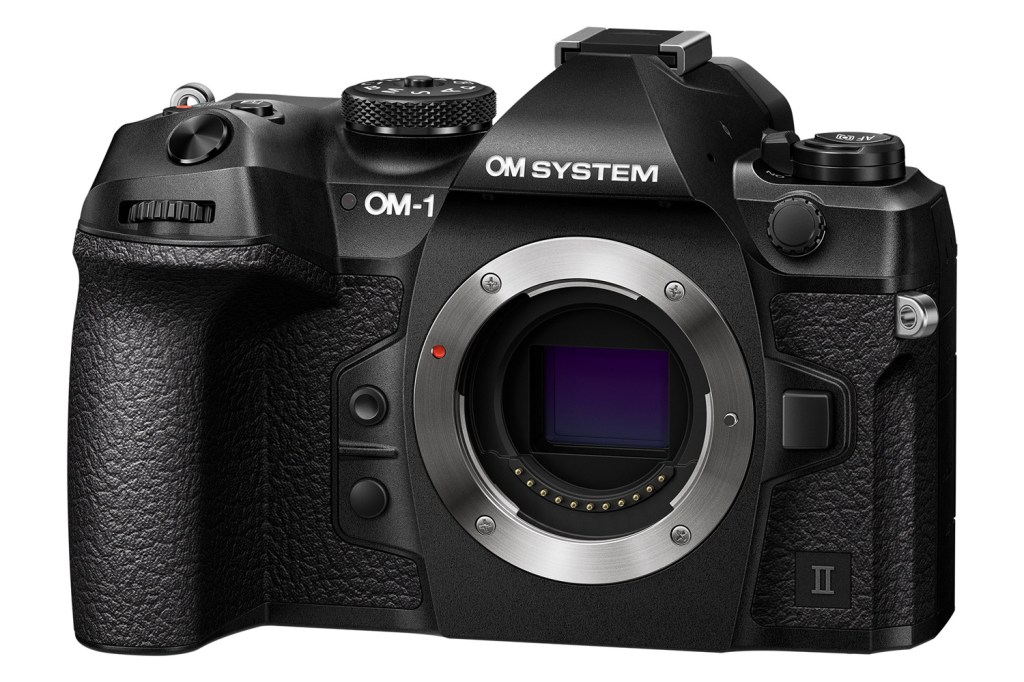OM System has announced the new OM-1 Mark II, an update to the OM-1, which is one of the best Olympus cameras you can currently buy. But what does the new Mark II version offer? Find out here.
OM System OM-1 Mark II at a glance:
- £2199 body only
- 20MP Four Thirds Stacked BSI Live MOS sensor
- 50fps with C-AF, 120fps fixed AF with extended buffer
- ISO80-102,400 (same)
- 1,053-point AI detect Quad Pixel AF improved, plus added human detection
- 5.76m-dot electronic viewfinder, 0.83x magnification
- 1.6m-dot 3inch vari-angle touchscreen
- 5-axis in-body stabilisation (8.5EV with Sync IS)
Read our OM System OM-1 Mark II preview with sample photos
Stand-out features:
- Live Grad ND filter – World’s first in-camera live graduated ND filter
- Hi-Res multi-shot now supports 14-bit raw recording
- Double the buffer size for increased continuous shooting (up to 256 raw shots)
- Improved continuous AF performance
OM System OM-1 Mark II in detail:
OM System has updated their previous flagship camera, the OM-1, with a new OM-1 Mark II version. It only seems like yesterday since the Olympus branded OM-1 was first announced, but it’s actually been nearly two years! If you’re familiar with the OM-1 already, then much of this will be familiar to you, so let’s start with some of the changes introduced with the new Mark II.
New features include the World’s first Live Graduated ND filter, which is built-in to the camera. The LiveND filter has been improved with an added stop. The high-resolution multi-shot mode now supports 14-bit raw shooting.
For fans of continuous shooting the buffer is now double the size, allowing for up to 213 raw shots at 120fps, and up to 256 raw shots when shooting at 50fps with continuous AF. The AF system has also been improved with better tracking as well as better AF during video. Subject detection was already quite impressive with cars, planes, trains, birds, and dogs and cats fully catered, but now human detection has been added.
There are a number of other improvements, including in-body image stabilisation (IBIS) which now can compensate for up to 8.5 steps. The command dials have been improved, with a rubber coating to aid grip, and the blackout free shooting has been improved as well.
Updates compared to the OM System OM-1:
- Live Grad ND filter (adjustable)
- Improved LiveND – with an added stop, now up to ND128 (7EV)
- Hi-res multi-shot now 14-bit RAW
- Double buffer size allows for more continuous shots (up to 213 raw at 120fps, 256 raw at 50fps C-AF)
- Improved continuous AF – improved tracking, as well as improved video AF performance
- Human detection added, with improved subject selection (pick from 8)
- Improved IBIS, now up to 8.5 steps (a 20% improvement)
- Rubber dials improves handling
- Blackout free shooting improved for slower continuous shooting speeds
- Improved in-camera focus-stacking/bracketing algorithms (up to 15 shots stacked internally)
- Supports vertical video
The core specifications of the camera remain the same, there’s still the ultra-high-speed 20MP Four Thirds sensor, which uses a BSI Stacked CMOS sensor. This allows for full-resolution shots at 120fps with fixed AF, or 50fps with continuous AF. Still amongst the fastest cameras in the world, and in comparison, the Nikon Z8/Z9 switches to 11MP when shooting at 120fps (albeit with AF) and if you want higher resolution, you’ll need to look at the £6500 Sony A9 III, with 120fps and continuous AF.
The new Live Grad ND filter gives you a number of options including GND2/GND4/GND8 (1,2,3EV), as well as soft, medium and hard filter type settings, and once switched on, you can move the position of the grad ND filter, as well as adjust the angle, with the display updating in real time so you can preview the settings.
You can also set the delete button to be a second “Menu” button to give quicker access to the menus, when holding the camera with one hand, without having to reach over to the top left of the camera.
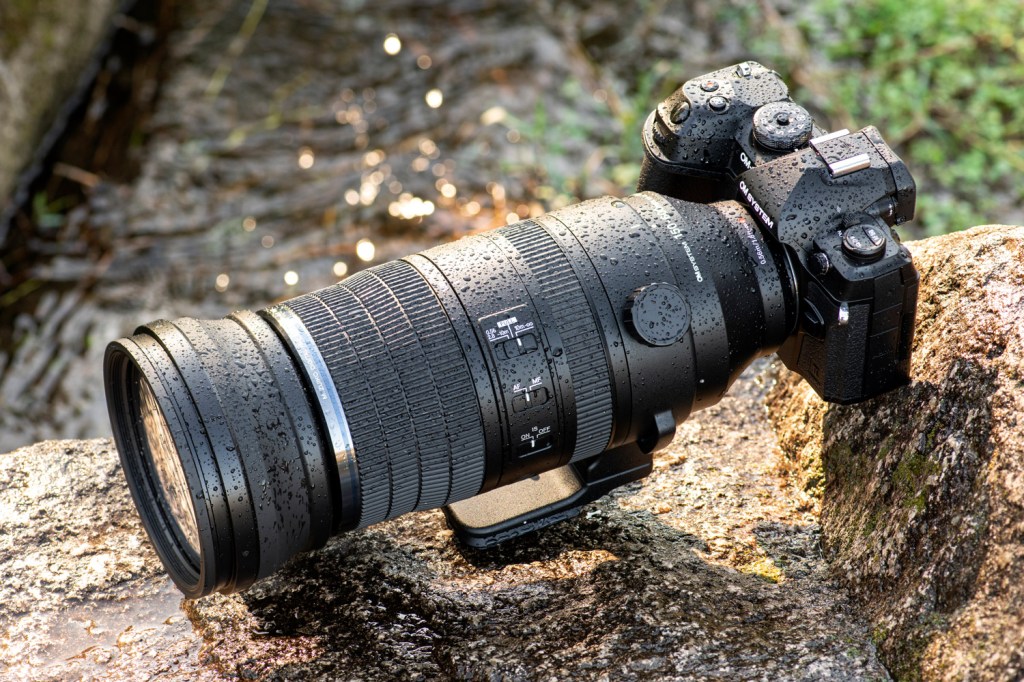
Read our OM System OM-1 Mark II preview with sample photos
From OM System: London, January 30, 2024 – OM Digital Solutions Corporation is excited to introduce the new flagship OM SYSTEM OM-1 Mark II. This Micro Four Thirds System standard-compliant interchangeable lens camera introduces a new global standard with the world’s first1 Live GND (Graduated ND) photography function. This ground-breaking feature harnesses computational photography to replicate the effects of a half ND filter, allowing users to adjust filter steps and types in real-time through the EVF or rear LCD, expanding creative possibilities. Scheduled for release in February, 2024, the OM SYSTEM OM-1 Mark II is poised to reveal the wonders of nature.
Crafted to withstand the most rugged outdoor conditions2, the OM SYSTEM OM-1 Mark II boasts an IP53-class splash & dustproof design, coupled with a robust body built to withstand freezing temperatures down to -10°C. This flagship model integrates cutting-edge technology, featuring up to 8.5 steps3 of 5-axis in-body image stabilization, a 20 Megapixel4 stacked BSI Live MOS sensor, and the latest TruePic X image processor, symbolizing the birth of a new flagship model bearing the OM SYSTEM brand.
Experience expanded imaging capabilities beyond traditional sensor limitations with 50M Handheld High Res Shot (approx.) and 80M Tripod High Res Shot functions (approx.), minimizing noise for RAW shots while delivering exceptional clarity. The OM-1 Mark II’s advanced AWB algorithm ensures precise colour reproduction, adapting seamlessly to diverse lighting conditions for accurate colour tones in every frame.
The AI Detection AF, developed using deep learning technologies, recognizes a wide spectrum of subjects, including birds, animals, cars and more, now includes humans, enhancing autofocusing for exceptional clarity, even under the most challenging conditions.
Elevating high-speed shooting performance, the OM-1 Mark II’s enhanced memory allows for an increased number of sequential shots. With Pro Capture, users can seize fleeting moments at up to 120 fps during AF/AE lock and approximately 50 fps during AF/AE tracking.
From improved grip surfaces to vertical video support, the OM-1 Mark II caters to user comfort and convenience. Additionally, it supports UVC/UAC connections to PCs for webcam use, catering to modern connectivity needs and an intuitive experience.
Complemented by accessories like the HLD-10 Power Battery Holder and the RM-WR1 Wireless Remote Control, this flagship model offers added functionality and convenience. The OM Workspace image editing software and OM Capture camera control software offer advanced editing features and seamless camera control, ensuring a comprehensive and refined photography experience.
Pricing & availability for OM SYSTEM OM-1 Mark II
The OM-1 Mark II will be available from 15th Feb 2024 at a suggested retail price of Camera body €2,399.00 / £2,199.99, OM SYSTEM OM-1 Mark II 12-40 II Kit PRO II €2,999.00 / £2,699.99
Detailed product specifications for the OM SYSTEM OM-1 Mark II
Please see the OM SYSTEM website for detailed product specifications:
https://explore.omsystem.com/om-1-mark-ii
OM SYSTEM OM-1 Mark II Features & Technology Detail
High-quality images thanks to a stacked BSI Live MOS sensor and TruePic X image processor
The OM SYSTEM OM-1 Mark II integrates a cutting-edge 20 Megapixel Stacked BSI Live MOS sensor alongside the advanced TruePic X image processor. This dynamic duo, coupled with renowned high-resolution M.ZUIKO DIGITAL lenses, deliver the highest quality images ever produced by an OM SYSTEM camera. An enhanced AWB algorithm delivers vivid colour reproduction, even in challenging lighting conditions like mixed lighting, ensuring precise colour tones across a variety of light sources for stunning photographs.
Additionally, the OM-1 Mark II features powerful 5-axis in-body image stabilization, improving compensation up to 8.5 steps with the body alone, as well as 5-axis sync IS5, further broadening opportunities for hand-held shooting by allowing the user to capture steady shots while maintaining agility and mobility.
The first1 in the world to enable users to control half ND filter effects while simultaneously reviewing GND steps and respective types
Introducing the world’s first Live GND (Graduated ND) shooting function, a ground-breaking technology that utilizes computational photography to replicate the effects of using a half ND, accurately controlling brightness and darkness within the image to create stunning output. Through Live GND shooting, users can seamlessly adjust filter steps (GND2, GND4, or GND8) and types (Soft, Medium, or Hard) in real-time through the EVF or rear LCD. This innovative approach allows for precise customization of the effect’s position and angle, empowering photographers to craft their envisioned images effortlessly. Without the need for physical filters attached to the lens, this feature enables photographers to leverage half ND effects, even with lenses lacking filter threads, significantly expanding creative expression in genres such as landscape photography. Elevating capabilities further, the OM-1 Mark II enhances the upper limit for step numbers in the popular Live ND shooting to ND128, allowing the camera to handle scenarios requiring larger step numbers.
The OM-1 Mark II introduces powerful imaging capabilities with functions like the approximately 50M Handheld High Res Shot and approximately 80M Tripod High Res Shot. These functions generate high-resolution images that surpass sensor limitations by merging multiple images and reducing noise by nearly two ISO sensitivity steps. They enable RAW recording at 14 bits for exquisite high-resolution shots. Complementing these features are convenient computational photography functions such as Live Composite, selectively illuminating brightened areas, and Focus Stacking, controlling the depth of field for precise subject focus and depth of field.
Advanced AI Detection AF now includes human recognition
Developed using deep learning technologies, the AI Detection AF has been enhanced to recognize an extensive array of subjects, including humans, formula racing cars, motorcycles, airplanes, helicopters, trains, birds, and common animals such as dogs and cats. This integration seamlessly enhances the well-established Face Priority / Eye Priority AF, significantly refining autofocus capabilities. It excels accurately identifying subjects, even when individuals are in profile, facing away, or obscured by hidden facial features.
The AI Detection AF harnesses the rapid computational prowess of the TruePic X image processor, providing instantaneous real-time detection of subjects’ movements. It accurately tracks subjects within the frame, ensuring they remain in focus without any loss, and extends its capability to follow intricate details like driver’s helmets or the eyes of birds and other animals, something not possible with human operation. It offers the capability to detect and track up to eight subjects, granting users the flexibility to select their preferred target for creating compelling images.
Enhancements have been made to usability, allowing for easy configuration of subject detection settings within the Super Control Panel. This streamlined feature empowers stress-free shooting experiences, providing users with greater control over their photographic endeavours.
Enhanced memory capacity allows a significantly greater number of sequential shots possible, resulting in improved high-speed shooting performance
The OM-1 Mark II features Pro Capture, initiating recording at the halfway press of the shutter button (1st release), recording, and storing previous frames from the moment the shutter button is fully pressed (2nd release). This ensures users never miss fleeting moments due to human reaction time, enabling high-speed sequential shooting at up to 120 fps during AF/AE lock and approximately 50 fps during AF/AE tracking, ensuring the capture of fast-moving subjects.
Equipped with expanded buffer memory, the OM SYSTEM OM-1 Mark II allows retrospective capture of approximately 99 in Pro Capture mode – an increase from the predecessor OM-1’s 70 frames. In sequential shooting, the OM-1 Mark II can capture approximately 219 frames in JPEG format or 213 frames in RAW shooting at approximately 120 fps, a dramatic improvement in high-speed shooting capability from the OM-1’s approximately 92 frames each.
IP53-class dustproof and splash proof performance for shooting in challenging environments, accompanied by a dependable reliable dust reduction system
The OM SYSTEM OM-1 Mark II features strategic sealing in appropriate locations across its robust, lightweight magnesium alloy body, providing IP53-class dustproof and splash proof performance. This construction ensures reliable operation even in harsh conditions, maintaining functionality in temperatures as low as -10°C, allowing shooting in the most demanding environments.
Its viewfinder is a 5.76 million dot organic EL (OLED), offering high resolution and an easy-to-see viewfinder magnification of 0.83x, a minimal display delay of 0.005 seconds6, and a high-speed display performance of 120 fps. This delivers clarity akin to an optical viewfinder while allowing users to view subjects even in low-light scenarios and preview the image before activating the shutter, characteristic advantages of electronic viewfinders. Additionally, it features an anti-fogging coating that prevents fog formation, ensuring a clear field of view, even when shooting in rainy conditions.
The OM-1 Mark II incorporates a reliable dust reduction system that prevents the accumulation of dust particles, either from internal components or during lens changes, on the image sensor surface. This robust system dramatically reduces the presence of dust and debris in captured images, contributing to sustained system reliability.
Other features
- Enhanced right-hand menu usability by assigning the trash barrel button as a menu shortcut, particularly beneficial when using a telephoto lens.
- AF/AE tracking high-speed sequential shooting (SH2) settings now include options for 12.5 fps and 16.7 fps.
- When shooting continuously at 25 fps or lower, the minimum shutter speed is set at 1/160 sec.
- Improved finger grip on dial surfaces utilizing elastomer processes.
- Compatibility with UVC (USB Video Class) / UAC (USB Audio Class), allowing seamless connection to a PC for use as a webcam.
- Offers support for convenient vertical video capture, ideal for social media platforms and similar applications.
Software and applications to support shooting and editing functionalities
OM Workspace image editing software, Version 2.3
The updated Olympus Workspace image editing software offers advanced RAW processing and editing capabilities. When connected to the OM-1 Mark II, it enables USB RAW Data Edit features, facilitating processing settings applicable both on the camera and during post-editing, such as tone curve adjustments and dehazing. In addition, it incorporates an AI Noise Reduction function specifically designed for RAW processing,9 resulting in clearer and enhanced images when applied to RAW files captured with a supported camera.10
OM Capture camera control software, Version 3.1
This software serves as a comprehensive camera control for computers, catering to the needs of studio photography. Facilitating seamless image transfer via Wi-Fi, it is a powerful assistant in studio shooting workflows. It supports high-speed communication capabilities within the 5 GHz band and is fully compatible with OM-1 Mark II operations. Additionally, it allows power supply via USB while controlling the camera.
OM Image Share smartphone app (OI.Share)
This smartphone app establishes a Wi-Fi connection to the camera, enabling the transfer of shooting data, and remote operation. With the OM-1 Mark II, OI.Share can be used to update the firmware on the camera body and allows users to back up and restore camera settings.


